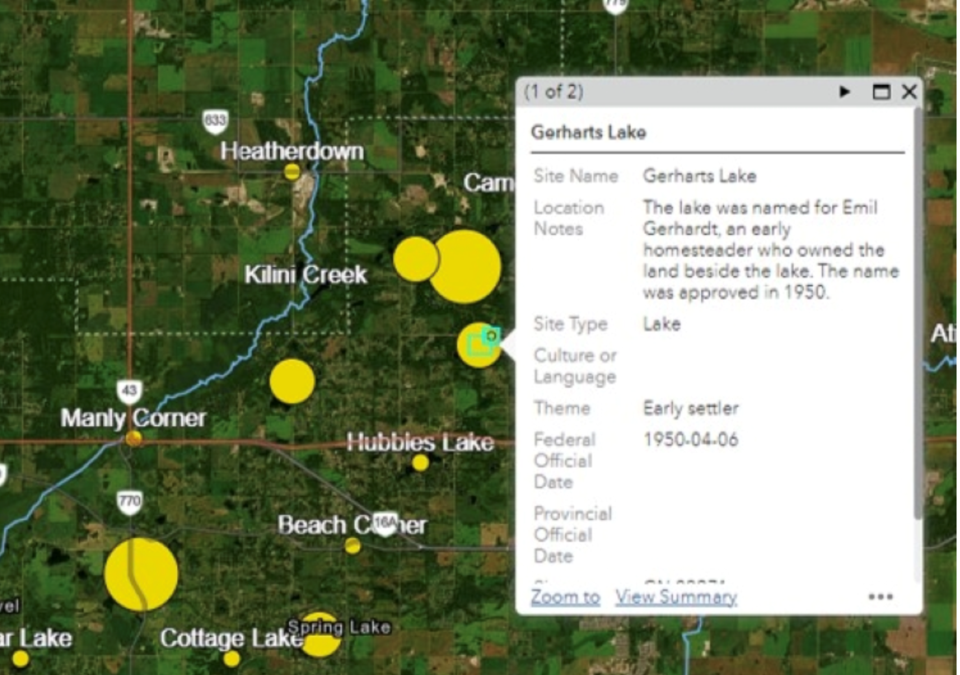ATHABASCA – A name is an integral part of what makes a community a community, but their origins are often shrouded in mystery and conjecture, or lost entirely.
A new tool from the Government of Alberta allows interested parties to travel back in time and learn where exactly their home town, workplace, or adopted community got its name from.
The tool, which overlays the data on a geo-spatial map of the province, compiles data from previous researchers into one handy tool — for Athabasca, Barrhead, and Westlock, much of that information comes from Volume III of Tracey Harrison’s Place Names of Alberta: Central Alberta, which tracks the history of the region.
“I think (the website) is great if people know it’s there,” said Anderson, gesturing to a variety of academic texts she’d laid out on a table. “These kinds of books, they take a little bit of leg work to find, but if the contents are online it’s a lot easier. It’s really proactive of the government to put it up there.”
“The Big River”
While historians tend to agree that Athabasca is an anglicization of a Cree word, that’s about as far as the consensus goes. In 1790, the lake was recorded as the “Lake of the Hills,” and the river listed as “Great Arabuska,” origin unclear. The Beaver — a Dene’zaa band — that lived along the river called it the Athapasco, or Elk River, and that name was recorded during Sir Alexander Mackenzie’s explorations in 1801.
To further complicate matters, David Thompson and Peter Fidler had explored the river the year prior, and had referred to it in journals as the Athabasca, using the Cree’s name instead.
The town took its name from the river it sits on. Originally named Athabaska Landing, a translation of the Cree word “caupawin,” the town got its start as a Hudson’s Bay Company trading post, where goods were shipped south into Edmonton, or into the North for frontiersmen. Formally incorporated as a town in 1911, the Landing portion was dropped, and the name was changed to its modern spelling in 1948.
Many other small communities trace their names back through the lineage of the post office or the railroad, which tied the north together. Moving south from Athabasca, Perryvale got its name from a relation of the postmaster, combined with the suffix -vale, for the hills and valleys surrounding the community. Rochester was named after Herbert Rochester, a rail company secretary and WWI veteran, and Clyde was named for the communities first postmaster, George D. Clyde. Pickardville was named after its first postmaster, William Pickard, and Dapp pulled its name from the initials of a railway accountant, David. A.P. Pennicuick.
Founding families
Westlock got its start as a post office, under the name of Edison. The land, six-and-a-half kilometres east of the present-day townsite, was owned by W.E. Westgate and a Mr. Lockhart. After it was purchased for a railway townsite in 1912, the first part of the two names were combined to give the town its modern day name.
In other communities, like Pibroch and Barrhead, settlers turned to home for naming inspiration. Barrhead, AB, got its title from James McGuire, an early settler who took the name from his birthplace of Barrhead, Scotland, 6,240 kilometres away.
Pibroch has a similar origin, albeit with an apocryphal twist — an early settler took the name from a Scottish town, which in term took its name from bagpipe music. The story goes that a cats meowing reminded the resident of the sound the instrument makes.
Other towns got their name from major events, or, from a hat. The hamlet of Rich Valley had originally been called Onion Prairie, but its first postmaster, Eric Carlin, evidently didn’t like it. In a naming contest, Rich Valley was pulled from a hat by his daughter, who had suggested the name.
Vimy was named after Canadian soldiers captured Vimy Ridge in April 1917, and it was formally approved for mapping purposes in 1945. No reason was listed as to why the first postmaster, Beart Benoit, chose the iconic event as the name for the community.



